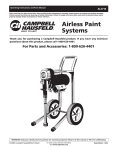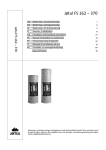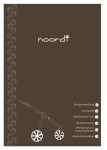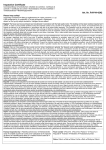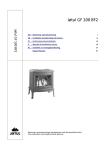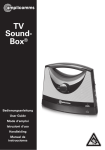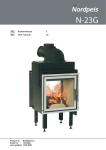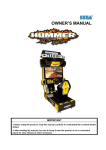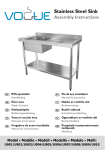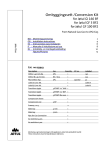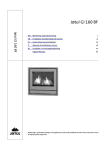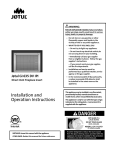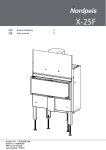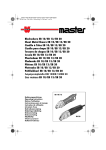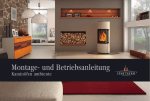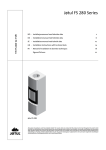Download Manual S 161
Transcript
Jøtul FS 161 - GI 160 BF Jøtul FS 161 - GI 160 BF Monterings- og bruksanvisning - Norsk Installation and Operating Instructions - English Instrucciones para instalación - Español Manuale di installazione ed uso - Italiano Figures/Pictures 3 5 7 9 11 Monterings- og bruksanvisningen må oppbevares under hele produktets levetid. These instructions must be kept for future references. 2 NORSK Kleberomramming til Jøtul GI 160 For montering av innsats - følg monteringsanvisningen for produktet. (Kat.nr. 350784) Jøtul FS 161 - GI 160 BF, er et produkt som kun må fyres med Naturgass G20/G25 eller konverteres til å fyre med LPG. Produktet er i samsvar med Forskrift om gassapparat og utstyr, fastsatt av Direktoratet for Brannog eksplosjonsvern 5. oktober 1994, samt Europeisk standard CEN EN 613 1998. Montering og installasjon må utføres av kompetent person i samsvar med: Montering-, installasjons- og bruksanvisninger som er vedlagt produktet. Installasjonen kan først tas i bruk når den er inspisert av kompetent person, og ferdigattest er gitt. Et typeskilt av varmebestandig materiale ligger mellom gassinnsatsens bunn og skjermplate. Det inneholder følgende informasjon; produsent, adresse, produktnavn, katalognummer, produksjonsnummer, effekt- og godkjenningsnummer (etter tildeling). Teknisk informasjon Høyde lav versjon: Høyde høy versjon: Bredde: Dybde: Vekt omramming: Vekt innsats: Vekt vedkubbesett: Vekt kullsett: Høyde senter røykuttak lav versjon: høy versjon: 1250 mm 1750 mm 760 mm 455 mm Lav-265 kg, høy-382 kg 44 kg 1,5 kg 2,1 kg se fig. 13 se fig. 14 Avstand fra omramming til vegg av brennbare materialer: Se fig. 1 Avstand i stråleretning til brennbare materialer : 700 mm Nødvendige hjelpemidler: Vater, måleband, hammer, gummihammer, platesaks. Viktig! Vær oppmerksom på at steinene kan ta skade ved hardhendt behandling! Skulle man være uheldig å få riper i overflaten, kan det pusses i overflaten med et fint sandpapir. Ved dypere sår kan det lages en pasta av klebersteinpulver og vannglass, og sparkle steinen med dette. Montering av lav versjon (5 høyder) Fig. 2 og 3 Se til at det er fri tilgang til inn- og utluft i skjermplaten. 1. Bestem hvor ildstedet skal stå (i forhold til skorsteinen). Gulvet inne i omrammingen skal dekkes av en stålplate (min. 0,9 mm) hvis ildstedet monteres på gulv av brennbart materiale. NB. Underlaget må være helt i vater. Max. 2 mm/m toleranse. Dette er svært viktig for resten av oppsettingen. Legg ut alle steinene og følg nøye nummereringen av steinene i henhold til figurene. Alle steinene skal være i vater. Bruk evt. små stålbiter eller sement for å justere høyden. 2. Rad 1 (Z55-Z56-Z57 - fig. 3, 5 og 6): • Legg ut første rad. • Fest sidene (Z 56 og Z57) mot frontsteinen (Z55) med hjelp av klammer (fig. 5 og 6 - 900031). • Bruk en hammer og slå ned festebrikkene (fig. 5 og 6 -900038). Vær forsiktig når disse slås ned slik at steinene ikke sprekker. • Fest stålplaten (fig. 6 - 910241) bak med festeklips (fig. 6 - 900286). • Legg bunnplaten (fig. 6 - 900289) på plass i omrammingen. • Fest monteringsbrakettene (fig. 6 - 910242) på hver side av bunnplaten med hjelp av de medfølgende skruer og muttere. 3. Rad 2 (Z251-Z54-Z53 - fig. 3,6 og 9): • Sett på plass frontsteinen (Z251) og sidesteinene (Z53 og Z54). • Legg gassinnsatsen på gulvet. Juster beina. Se fig. 7 A • Løft opp gassinnsatsen (fig. 7) og plasser den med beina på monteringsbrakettene (fig. 6 - 910242). Fest beina til brakettene med hjelp av de medfølgende skruer og muttere. • OBS. innsatsen er tung! Sørg for hjelp til løfting. 4. Montering av adapter • For å kunne montere adapteret (fig. 7 B), må skjermplatene (fig. 9) på toppen og bak innsatsen taes av. Fjern først skruene (6 stk) som fester skjermplaten på toppen og løft av platen. Fjern også skjermplaten bak som er festet med 8 muttere. • Dersom det ønskes at ildstedet skal avgi mer varme til kleberomrammingen, kan skjermplatene rundt innsatsen fjernes. • Kontroller at pakningen rundt røykuttaket er intakt. Det er festet med 4 karrosseriskruer Ø4,2mm. • Sett på adapteret og mål ut hvor det skal tas hull til pipe, og tilpass røykrørene. • Skruene løsnes, og adapteret festes med de samme 4 karrosseriskruene, slik at røret blir stående vannrett. For å tette alle skjøter mellom røykrørene skal det brukes varmebestandig tettemiddel. • For montering av avtrekkssystem, se avsnittet: ”Avtrekkssystem for montering rett ut gjennom vegg» i hovedmanualet for Jøtul GI 160 BF. 5. Rad 3 og 4 (Z58-Z53-Z54 - fig. 3&10): • Sett på plass sidesteinene (fig. 3 - Z53 og Z54) og de 3 NORSK 6. • • • små frontsteinene (fig. 10 - Z58). Fest med brikker og klammer. Rad 5 (Z59-Z61-Z60 - fig. 3 og 11): Sett på plass frontstein (Z59) og sidesteinene (Z60 og Z61). Monter avstandsstykkene-se fig. 11 (910249-900288) og legg på risten. Toppristen må tilpasses (klippes til) røykrøret. Legg på topplaten (fig. 3 - Z417) og et evt. røykhullsdeksel (fig. 3 - Z418). Montering av høy versjon (7 høyder) Fig. 2 og 4 I tilleggsesken ligger 2 lag med stein for høy versjon (Z52Z53-Z54). 1. Se til at det er fri tilgang til inn- og utluft i skjermplaten. 2. Bestem hvor ildstedet skal stå (i forhold til pipe) Gulvet inne i omrammingen skal dekkes av en stålplate (min. 0,9 mm) hvis ildstedet monteres på gulv av brennbart materiale. NB. Underlaget må være helt i vater. Max. 2 mm/m toleranse. Dette er svært viktig for resten av oppsettingen. 3. Legg ut alle steinene og følg nøye nummereringen av steinene i henhold til figurene. 4. Legg først ut lag 1 med steiner-se fig. 3 og 6 -(Z52Z53-Z54) 5. Se til at alle steinene er i vater. Bruk evt. små stålbiter eller sement for å justere høyden. 6. Fest sidene mot frontsteinen med hjelp av klammer (fig. 5 og 6 - 900031). 7. Bruk en hammer og slå ned festebrikkene (fig. 5 og 6 -900038). Vær forsiktig når disse slås ned slik at steinene ikke sprekker. 8. Fest stålplaten (fig. 6 - 910241) bak med festeklips (fig. 6 - 900286) 9. Legg bunnplaten på plass i omrammingen (fig. 6). 10. Fest monteringsbrakettene (fig. 6 - 910242) på hver side av bunnplaten med hjelp av de medfølgende skruer og muttere. 11 Den ekstra skjermplaten bak til omrammingen, høy versjon, skal monteres nederst med den eksisterende skjermplaten øverst (fig. 14). 12. Sett på plass 2. lag med steiner (Z55-Z56-Z57). Husk å feste med festebrikker og klammer - Se fig. 4. 13. Sett på plass frontsteinen (Z251) i 3. lag og sidesteinene (Z53 og Z54). Se fig. 4. 14. Legg gassinnsatsen på gulvet. Juster beinene. Se fig. 7A 15. Løft opp gassinsatsen (fig. 7) og plasser den med beina på monteringsbrakettene (fig. 6 - 910242 og 900289). Juster innsatsen slik at den står riktig posisjonert i forhold til omrammingen. Fest beina godt til brakettene med hjelp av de medfølgende skruer og muttere. OBS. innsatsen er tung! Sørg for hjelp til løfting. 16. Montering av adapter 4 • For å kunne montere adapteret (fig. 7 B), må skjermplatene (fig. 9) på toppen og bak innsatsen taes av. Fjern først skruene (6 stk) som fester skjermplaten på toppen og løft av platen. Fjern også skjermplaten bak som er festet med 8 muttere. • Dersom det ønskes at ildstedet skal avgi mer varme til kleberomrammingen, kan skjermplatene rundt innsatsen fjernes. • Kontroller at pakningen rundt røykuttaket er intakt. Det er festet med 4 karrosseriskruer Ø4,2mm. • Sett på adapteret og mål ut hvor det skal tas hull til pipe, og tilpass røykrørene. • Skruene løsnes, og adapteret festes med de samme 4 karrosseriskruene, slik at røret blir stående vannrett evt. rett opp og ut med 900 bend. For å tette alle skjøter mellom røykrørene skal det brukes varmebestandig tettemiddel. • For montering av avtrekkssystem, se avsnittet: ”Avtrekkssystem for montering rett ut gjennom vegg» i hovedmanualet for Jøtul GI 160 BF. 17. Sett på plass 4. og 5. rad med sidesteinene (fig. 4 - Z53 og Z 54) og de små frontsteinene (fig. 10 - Z58). Fest med brikker og klammer. 18. Sett på plass lag 6 (fig. 4 - Z52- Z53-Z54) fra tilleggsesken. 19. Sett på plass lag 7 med steiner (fig. 4 - Z59-Z60-Z61). 20. Monter avstandsstykkene-se fig. 10 (910249-900288) og legg på risten. Toppristen må tilpasses (klippes til) røykrøret. 21. Legg på topplaten (fig. 4 og 15 - Z417) og et evt. røykhullsdeksel (fig. 4 og 15 - Z418). ENGLISH Soap stone surround for Jøtul GI 160 BF This product, the Jøtul FS 161 - GI 160 BF may only be used with Natural Gas or be converted for the use of Butane or Propane. The product is in accordance with Regulations for Gas Appliances and Equipment, established by the European Standard CEN EN 613 1998. 3. 4. Assembly and installation must be performed by a qualified person in accordance with the instructions for assembly, installation and use enclosed with the product. In the UK this includes the Gas Safety (Installation & use) Regulations 1998.The installation may only be operated after it has been inspected by a qualified person and a certificate of completion has been issued. 5. A product data plate in heat resistant material can be found between the gas insert base and the heat shield. The following information is listed on the data plate: Manufacturer and address, model number, manufacturing number, rated heat output, registration number (after assignment), style, and safety measurements. 8. Technical information Height low version Height high version Width: Depth: Weight of surround: Weight insert: Weight log set: Weight coal set: Height centre flue outlet low version: high version: 1,250 mm 1,750 mm 760 mm 455 mm Low 265 kg, high 382 kg 44 kg 1,5 kg 2,1 kg fig. 13 fig. 14 Distance from surround to walls of flammable materials:See fig. 1 Min. distance between furniture and the front of the fireplace: 700 mm. Necessary tools: Spirit level, tape measure, hammer, rubber hammer, sheet metal shears. Mounting Remember that the stones can easily be damaged if they are not handled with care. If the surface becomes scrathed, it can be polished with fine sandpaper. Deeper scratches can be repaired by filling the scratch with a paste made from soap stone powder and water glass. 1. Make sure that there is adequate ventilation for the screen plate. 2. Decide where the fireplace will stand (in relation to the chimney). Flooring within the surround must be covered 6. 7. by a steel plate (minimum thickness 0.9 mm) if the fireplace is to stand on a floor of combustible material. Note! The underlay must be completely level. Max. 2 mm/m tolerance. This is very important for the rest of the installation process. Lay out all the stones carefully following the numbering of the stones as shown in the figures. First lay out the stones for layer 1. See fig. 3 (Z55-Z56Z57). Make sure that all the stones are level. If necessary use small pieces of steel or cement to adjust the height of the stones. Attach the side to the front stone with the help of clamps (fig. 5 - 6, 900031). Use a hammer to fix the mounting pieces (fig. 5-6, 900038). Be careful not to split the stones when hammering in the clamps. Attach the steel plate (fig. 6 - 910241) to the back with the clips (fig. 6 - 900286). Installation of the low version (5 heights) - Fig. 3 1. Fasten the mounting brackets (fig. 7 - 910242) to each side of the base plate using the nuts and bolts provided. 2. Place the base plate with the mounting brackets in the surround (fig. 7). 3. Position the second front stone (fig. 3 and 9 - Z251) and sidestones (Z53 and Z54). 4. Lift the gas insert and place it with the legs on the mounting brackets. Note! The product is heavy. Make sure you have assistance when rising it and putting it in place. 5. Adjust the insert so that it stands in the correct position in relation to the surround. 6. Fasten the legs to the brackets using the nuts and bolts provided. 7. Positioning the adapter: • In order to position the adapter remove the heat shield on top of the gas insert by unscrewing the 6 screws. Remove also the rear heat shield by unscrewing the 8 nuts. • Check that the gasket around the flue pipe is intact. The flue pipe is fastened using four screws, Ø4.2mm. • Position the adapter and measure where the hole for the chimney is to be placed and adjust the flue pipes. • Loosen the screws and fasten the adapter with the same four screws so that the flue pipe is horizontal. • Use heat-resistant sealant to seal all joins. • Attach the exhaust hood with 410 mm length to the adapter. • Replace the heat shield on top and rear. 8. Place the third and fourth row of side stones in position (fig. 3 - Z53 and Z 54) and the small front stones (fig. 12 - Z58). Fix with fixing pieces and clamps. 9. Place row five in position using the front stone (fig. 15 Z59) and the side stones (fig. 14 - Z60). 10. Attach the spacers. See fig. 14 (900287-900288) and position the grate. The top grate must be adjusted (cut) 5 ENGLISH to fit the flue pipe. 11. Lay the top plate on top (fig. 15 - Z417) and, if needed, a flue outlet cover (fig. 15 - Z418). Installing of the high version (7 heights) - fig. 4 There are two layers of stones in the additional box (Z52Z53-Z54). • The extra heat shield at the back of the surround (high version) is to be mounted at the bottom with the existing heat shield above. See fig. 16. • Place stones Z52-Z53-Z54 on the floor (after levelling the floor). Then follow the same instructions and order of installation as for the low version. Remember to attach the fixing pieces and clamps. • After the insert has been positioned, the first set of stones (no. Z52-Z53-Z54) from the additional box can be laid down, then follow the procedure given for the low version. 6 ESPAÑOL Mampostería de piedra esteatita para la Jøtul GI 160 BF Este producto, Jøtul FS 161 - GI 160 BF sólo se puede utilizar con gas natural o convertirse para su utilización con butano o propano. Este producto cumple la normativa relativa a herramientas y equipos de funcionamiento por gas, establecida por la norma europea CEN EN 613 1998. El montaje y la instalación deben ser realizados por una persona cualificada de acuerdo con las instrucciones de montaje, instalación y uso que se incluyen con el producto. Entre la base de la estufa de inserción de gas y la protección térmica se encuentra una placa de características del producto fabricada con material resistente al calor. En esta placa figura la siguiente información: Fabricante y dirección, número de modelo, número de fabricación, producción térmica estimada, número de registro (después de haberla asignado), estilo y medidas de seguridad. Información técnica Versión de altura baja Versión de altura elevada Anchura: Fondo: Peso - approx. Altura centro de salida de humos versión baja: versión alta : 1.250 mm 1.750 mm 760 mm 455 mm mampostería de piedra: versión baja 265 kg, versión alta 382 kg 44 kg (producto) 1,5 kg (conjunto de troncos) 2,1 kg (conjunto de trozos de carbón) fig. 13 fig. 14 Distancia desde la mampostería de piedra al muro de material inflamable: vea la figura 1. La distancia mínima que se debe guardar con el material combustible en la parte frontal de la estufa es de 700 mm. Herramientas necesarias: nivel, cinta métrica, martillo, martillo de goma, cizallas metálicas (tijeras de hojalatero) Instalación: Tenga presente que las piedras se pueden dañar fácilmente si no se manejan con cuidado. Si la superficie se raya, se puede pulir con papel de lija fino. Los arañazos más profundos se pueden reparar rellenando el hueco con una pasta hecha a base de polvo de esteatita y silicato sódico líquido (vidrio soluble). 1. Compruebe que dispone de ventilación adecuada para la pantalla. 2. Decida la ubicación de la estufa (en relación con la chimenea). Si la estufa se va a instalar sobre un suelo 3. 4. 5. 6. 7. 8. de material inflamable, el suelo del área de mampostería debe cubrirse con una plancha de acero de un grosor mínimo de 0,9 mm. Nota: el suelo sobre el que se va a colocar debe estar perfectamente nivelado; tolerancia máxima 2 mm/m. Este detalle es de importancia fundamental para el resto del proceso de instalación. Disponga todas las piedras con cuidado siguiendo su numeración, tal y como se muestra en las figuras. Coloque primero las piedras para la capa 1. Vea la figura 3 (Z55-Z56-Z57). Compruebe que todas las piedras están al nivel. Si es preciso, utilice trozos pequeños de acero o cemento para ajustar la altura de las piedras. Acople el lateral a la piedra frontal con ayuda de abrazaderas. Vea la figura 5 y 6 (900031). Utilice un martillo para asegurar las piezas de montaje (figura 5 y 6 - 900038). Tenga cuidado para no partir las piedras al golpear las abrazaderas con el martillo. Acople la plancha de acero a la parte posterior con los clips (figura 6 - 900286). Instalación de la versión de poca altura (5 alturas) - Fig. 3 1. Apriete las abrazaderas de montaje (fig. 5 - 910242) situadas a cada lado de la placa base mediante las tuercas y los pernos suministrados. 2. Coloque la placa base con las abrazaderas de montaje en el hueco de la mampostería (fig. 7). 3. Coloque la segunda piedra frontal (fig. 3 - Z251). 4. Nota: El producto pesa mucho.Necesitará ayuda tanto para montarlo como para colocarlo en su posición. Levante la estufa de inserción de gas y colóquela con las patas sobre las abrazaderas de montaje. 5. Ajuste la estufa de inserción de forma que quede situada en la posición correcta en el hueco de la mampostería. 6. Acople las patas a las abrazaderas mediante las tuercas y los pernos suministrados. 7. Montaje del adaptador: • Retire los seis tornillos que aseguran la protección térmica en la parte superior de la estufa de inserción de gas. • Saque la placa. • Afloje la protección térmica en su parte posterior. Está fijada por medio de tuercas 8xM6 • Compruebe que la junta que rodea la salida de humos en la parte posterior de la estufa está intacta. Ésta se sujeta con 4 tornillos de Ø4,2 mm. • Coloque el adaptador y mida la posición donde quedará el orificio para la chimenea; ajuste los tubos de humos. • Afloje los tornillos y fije el adaptador con los mismos cuatro tornillos nivelantes de modo que el tubo quede en posición horizontal. • Selle todas las juntas con sellante resistente al calor. • Acople la campana extractora con longitud de 7 ESPAÑOL conducto de 410 mm al adaptador. • Vuelva a colocar la protección térmica en la parte superior y posterior. 8. Coloque la tercera y cuarta filas de piedras laterales en su sitio (fig. 3 - Z53 y Z 54) y las piedras frontales pequeñas (fig. 3 - Z58). Asegúrelas con piezas de fijación y abrazaderas. 9. Coloque la quinta fila en su sitio utilizando la piedra frontal (fig. 15 - Z59) y las piedras laterales (fig. 14 - Z60). 10. Coloque las piezas de separación. Consulte la fig. 14 (900287-900288) y coloque la parrilla. La parrilla superior se debe ajustar para que encaje en el tubo de salida de humos. 11. Coloque la placa superior encima (fig. 15 - Z417) y haga lo mismo con cualquier cubierta de orificio de humos que utilice (fig. 15 - Z418). Instalación de la versión de altura elevada (7 alturas) - Fig. 4 La caja adicional contiene dos capas de piedras (Z52 - Z 53 Z54). • La protección térmica adicional situada en la parte posterior del hueco de la mampostería se debe montar en la parte inferior con la protección térmica existente encima. Vea la figura 16. • Coloque las piedras Z52-Z53-Z54 sobre el suelo (después de nivelarlo). Siga después las mismas instrucciones y en el mismo orden de instalación que para la versión de poca altura. No olvide colocar las piezas de sujeción y las abrazaderas. • Una vez que la estufa de inserción esté en su posición, podrá colocar el primero juego de piedras (Z52-Z53-Z54) de la caja adicional y seguir después el mismo procedimiento que para la versión de poca altura. 8 ITALIANO Intelaiatura in pietra ollare per Jøtul FS 161 - GI 160 BF Il Jøtul FS 161 - GI 160 BF deve essere utilizzato solo con gas naturale oppure può essere convertito per l’impiego di gas GPL. Questo prodotto è conforme alle disposizioni in materia di apparecchiature e dispositivi a gas stabilite dal Direttorato norvegese per la prevenzione di incendi ed esplosioni in data 5 ottobre 1994 e specificate dallo standard europeo CEN EN 613 1998. Il montaggio e linstallazione devono essere effettuati da un tecnico conformemente alle istruzioni per l’assemblaggio, l’installazione e luso fornite con il prodotto. Linstallazione può essere utilizzata solo dopo essere stata ispezionata da un tecnico e dopo lemissione di un certificato di completamento. Tra la base dell’inserto del gas e lo scudo termico si trova una piastra con i dati del prodotto, in materiale termoresistente. Sulla piastra informativa si trovano le seguenti informazioni: Produttore e indirizzo, numero del modello, numero di serie, uscita di calore prevista, numero di registrazione (dopo l’assegnazione), modello e misure di sicurezza. Il timbro di controllo si trova accanto alla piastra. Dati tecnici Versione bassa Versione alta Larghezza: Profondità: Peso circa Altezza centro di scarico fumi versione bassa: versione alta: 1.250 mm 1.750 mm 760 mm 455 mm dell’intelaiatura: versione bassa 265 kg, versione alta 382 kg Prodotto: 44 kg Chiocchi: 1,5 kg Carboni: 2,1 kg fig. 13 fig. 14 Distanza dell’intelaiatura da pareti costruite con materiale infiammabile: Vedere fig. 1. La distanza davanti del prodotto alle mobilie: Min. 700 mm Strumenti necessari: livella ad acqua, metro a nastro, martello, martello di gomma, cesoie per fogli di metallo (forbici da lattoniere). Installazione Tenere presente che le pietre possono subire danni se non vengono maneggiate con attenzione. Se la superficie viene graffiata, può essere rifinita con carta vetrata sottile. Graffi più profondi possono essere riparati riempiendoli con una pasta composta da polvere di pietra ollare e vetro solubile. 1. Verificare che la ventilazione necessaria alla piastra schermo sia sufficiente. 2. Stabilire la posizione del caminetto, in relazione alla cappa. Se il camino verrà posizionato su un pavimento di materiale combustibile, è necessario rivestire il pavimento intorno all’intelaiatura con una lastra di acciaio dallo spessore minimo di 0,9 mm. Nota! L’inclinazione deve essere completamente a livello. Massimo di tolleranza consentito: 2 mm/m. Questa accortezza è fondamentale per il resto del processo di installazione. 3. Disporre tutte le pietre con attenzione, seguendo la numerazione riportata, come illustrato nelle figure. 4. Disporre innanzitutto le pietre del primo strato. Vedere fig. 3 (Z55-Z56-Z57). 5. Verificare che tutte le pietre siano a livello. Se necessario, utilizzare piccole parti di acciaio o cemento per regolare l’altezza delle pietre. 6. Collegare il bordo della pietra anteriore utilizzando gli appositi fermi. (Vedere fig. 5 e 6 - 900031). 7. Utilizzare un martello per fissare i pezzi da montare (fig. 5 e 6 - 900038). Fare attenzione a non colpire le pietre quando si martellano i fermi. 8. Collegare la lastra di acciaio al retro mediante gli appositi supporti (fig. 6 - 900286). Montaggio della versione bassa (5 altezze) - fig. 3 1. Fissare i supporti di montaggio (fig. 7 - 910242) su ogni lato della piastra di base utilizzando i dadi e i bulloni forniti con il prodotto. 2. Posizionare la piastra di base con i supporti di montaggio nell’intelaiatura (fig. 7). 3. Posizionare la seconda pietra anteriore (fig. 3 - Z251). 4. Sollevare l’inserto del gas e posizionarlo con le gambe sui supporti di montaggio. NB.: Il prodotto è pesante. Avrete bisogno di aiuto durante l’assemblaggio ed il collocamento del prodotto. 5. Posizionare l’inserto e regolarlo alla giusta altezza in relazione all’intelaiatura. 6. Fissare le gambe ai sostegni utilizzando i dadi e i bulloni forniti con il prodotto. 7. Posizionare l’addatore • Rimuovere le sei viti che fissano lo scudo termico alla parte superiore dell’inserto del gas. Sollevare la piastra. Rimuovere gli otto dadi che fissano lo scudo termico alla parte posteriore dell’inserto del gas. Sollevare la piastra. 9 ITALIANO • Posizionare l’adattatore, misurare la sezione del foro in cui dovrà essere collocata la canna fumaria e adattare i tubi per il fumo. • Verificare che la guarnizione intorno allo scarico fumi dietro alla stufa sie integra. Fissarla con l’ausilio di 4 viti con un diametro di 4,2 mm. • Allentare le viti e fissare l’adattatore con le stesse quattro viti piatte facendo in modo che il condotto venga a trovarsi in posizione orizzontale. • Per sigillare tutte le giunzioni usare un materiale a tenuta termoresistente. • La cappa di scarico con il tubo, 410 mm, viene collegato all’adattatore alla stufa. • Installare gli schermi termici. 8. Collocare il terzo e quarto strato di pietre laterali (fig. 3 - Z53 e Z 54) e le pietre piccole frontali (fig. 12 - Z58). Fissarle con i dispositivi di fissaggio e gli appositi fermi. 9. Posizionare correttamente il quinto strato usando la pietra frontale (fig. 15 - Z59) e le pietre laterali (fig. 14 Z60). 10. Collegare i distanziatori. Vedere fig. 14 (900287-900288) e posizionare la grata. Adattare (tagliare) la grata superiore prima di posarla sul condotto del fumo. 11. Posare la piastra superiore (fig. 15 - Z417) e procedere analogamente con il copri foro per la canna (fig. 15 Z418). Montaggio della versione alta (7 altezze) - fig. 4 La scatola aggiuntiva contiene altri due strati di pietre (Z52Z53-Z54). Lo scudo termico aggiuntivo sul retro dell’intelaiatura (versione alta) deve essere montato nella parte inferiore, con lo scudo termico esistente posto nella sezione superiore. Vedere fig. 16 • Disporre le pietre del secondo strato (Z52-Z53-Z54). Quindi seguire le stesse istruzioni e la sequenza di istallazione indicata per la versione bassa. Ricordare di collegare gli appositi ganci e fermi. • Dopo aver posizionato l’inserto, è possibile disporre il primo gruppo di pietre (Z52-Z53-Z54) contenuto nella scatola aggiuntiva, quindi seguire la procedura indicata per la versione bassa. 10 Fig. 1 Fig. 2 Fig.3 Fig.4 Fig.5 Fig. 6 11 Fig. 8 B Fig. 7 A Fig. 10 Fig.9 A A B Fig. 11 Fig. 13 Fig. 14 14 15 Cat.no. 221244 Draw.no. 4-4330-P00 Jøtul AS, Sept. 2004 Jøtul arbeider kontinuerlig for om mulig å forbedre sine produkter, og vi forbeholder oss retten til å endre spesifikasjoner, farger og utstyr uten nærmere kunngjøring. Jøtul pursue a policy of constant product development. Products supplied may therefore differ in specification, colour and type of accessories from those illustrated and described in the brochure. Kvalitet Jøtul AS arbeider etter et kvalitetssikringssystem basert på NS-EN ISO 9001 for utvikling, produksjon og salg av ildsteder. Vår kvalitetspolitikk skal gi kundene den trygghet og kvalitetsopplevelse som Jøtul har stått for siden bedriftens historie startet i 1853. Quality Jøtul AS has a quality system that conforms to NS-EN ISO 9001 for product development, manufacturing, and distribution of stoves and fireplaces. This policy gives our customers quality and safety piece of mind as a result of Jøtul’s vast experience dating back to when the company first started in 1853. Dette ildstedet er kontrollert av: This product has been controlled by: Jøtul AS, P.o. box 1411 N-1602 Fredrikstad, Norway ________________________ Date: ___________________ Sign:
















